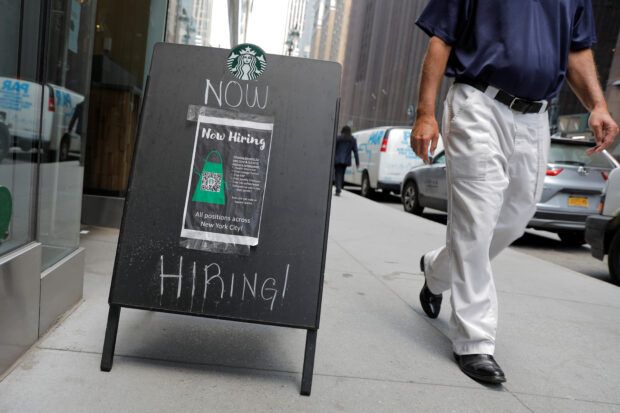US weekly jobless claims at 16-month low; homebuilding eases

A sign advertising job openings is seen outside of a Starbucks in Manhattan, New York City, New York, U.S., May 26, 2021. REUTERS/Andrew Kelly/File photo
WASHINGTON – The number of Americans filing new claims for unemployment benefits fell last week to the lowest level in nearly 1-1/2 years, suggesting job growth likely remained solid in January.
The unexpected decline in initial claims reported by the Labor Department on Thursday added to strong retail sales growth in December in painting an upbeat picture of the economy, and could make it difficult for the Federal Reserve to start cutting interest rates in March as financial markets anticipate.
“The labor market remains strong and reinforces our view that the Fed is likely to hold rates at current levels until the middle of 2024,” said Eugenio Aleman, chief economist at Raymond James.
READ: Strong US retail sales underscore economy’s momentum heading into 2024
Initial claims for state unemployment benefits dropped 16,000 to a seasonally adjusted 187,000 for the week ended Jan. 13, the lowest level since September 2022. Economists polled by Reuters had forecast 207,000 claims for the latest week.
Claims data tend to be volatile at the turn of the year. Some of the volatility relates to fewer layoffs after the holidays than is normal.
While that could have contributed to some of the drop in claims, economists said the data was consistent with a fairly tight labor market. They noted that companies generally remained reluctant to lay off workers following difficulties finding labor during and after the COVID-19 pandemic.
Unadjusted claims decreased 29,543 to 289,228 last week, with filings plunging by 17,176 in New York.
There were also significant declines in Michigan, Pennsylvania, Wisconsin, South Carolina, Georgia and Minnesota, which more than offset notable increases in California, Iowa, Kansas and Texas.
“Seasonal layoffs after the holiday season have been milder than usual, leading to a decline in the published seasonally adjusted level of claims,” said Lou Crandall, chief economist at Wrightson ICAP.
“This is not an example of a seasonal ‘distortion’ because the labor market tightness that is making employers wary of laying workers off temporarily is real.”
Stocks on Wall Street were mixed while the dollar rose against a basket of currencies. U.S. Treasury prices fell.
Financial markets have lowered their bets for a rate cut at the U.S. central bank’s March 19-20 policy meeting to below 60 percent, according to CME Group’s FedWatch Tool.
READ: Fed rate cuts may wait as inflation ticked up in December
Fed Governor Christopher Waller said this week that the economy was “doing well” and giving the U.S. central bank “the flexibility to move carefully and methodically.”
The Fed has hiked its policy rate by 525 basis points to the current 5.25%-5.50% range since March 2022.
Jobless rolls shrink
The claims data covered the period during which the government surveyed employers for the nonfarm payrolls component of January’s employment report.
READ: US job openings fell slightly in November
Claims fell between the December and January survey period, suggesting that strong job growth persisted this month. The economy added 216,000 jobs in December.
Data next week on the number of people receiving benefits after an initial week of aid, a proxy for hiring, will offer more clues on the state of the labor market in January.
The so-called continuing claims decreased 26,000 to 1.806 million during the week ending Jan. 6, the lowest since October, the claims report showed.
Homebuilding paused in December after strong gains in the prior three months.
Single-family housing starts, which account for the bulk of homebuilding, fell 8.6 percent to a seasonally adjusted annual rate of 1.027 million units last month, the Commerce Department’s Census Bureau said in a separate report. Wet weather last month likely contributed to the plunge in homebuilding.
Single-family starts increased 15.8 percent on a year-on-year basis as a shortage of previously owned houses for sale fuels demand for new construction. Permits for future construction of single-family homes increased 1.7 percent to a pace of 994,000 units last month, the highest level since May 2022.
That aligns with a recent sharp improvement in homebuilder sentiment and reflects declining mortgage rates.
The perennial inventory shortage has combined with still high mortgage rates to weigh on sales of previously owned homes. But new construction demand is boosting residential investment, which rebounded in the third quarter after nine straight quarterly decreases, supporting the economy.
Starts for housing projects with five units or more increased 7.5 percent to a rate of 417,000 units in December.
READ: US new-home sales fell in Dec., sales for year up
Overall housing starts fell 4.3 percent to a rate of 1.460 million units in December. Starts declined 9 percent to 1.413 million units in 2023. Multi-family building permits rose 1.4 percent to a rate of 449,000 units last month. Building permits as a whole increased 1.9 percent to a rate of 1.495 million units. They dropped 11.7 percent to 1.470 million units in 2023.
The single-family homebuilding backlog rose 0.7 percent to 140,000 units last month, while the rate for completions jumped 8.4 percent to 1.056 million units, the highest level since November 2022. The inventory of single-family housing under construction decreased 1.2 percent to a rate of 671,000 units.
Housing completions increased 4.5 percent to 1.453 million units in 2023. According to the National Association of Realtors, the inventory of previously owned homes on the market is just above 1 million units, well below nearly 2 million units before the COVID-19 pandemic.
Realtors estimate housing starts and completion rates need to be in a range of 1.5 million to 1.6 million units per month to bridge the inventory gap.
“More supply is still needed,” said Orphe Divounguy, a senior economist at Zillow. “Due to more than a decade of underbuilding, a significant shortage of housing options is fueling America’s housing affordability crisis.”